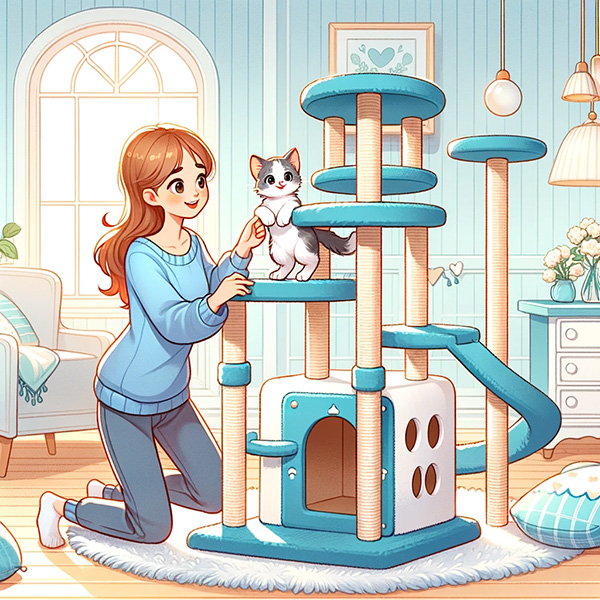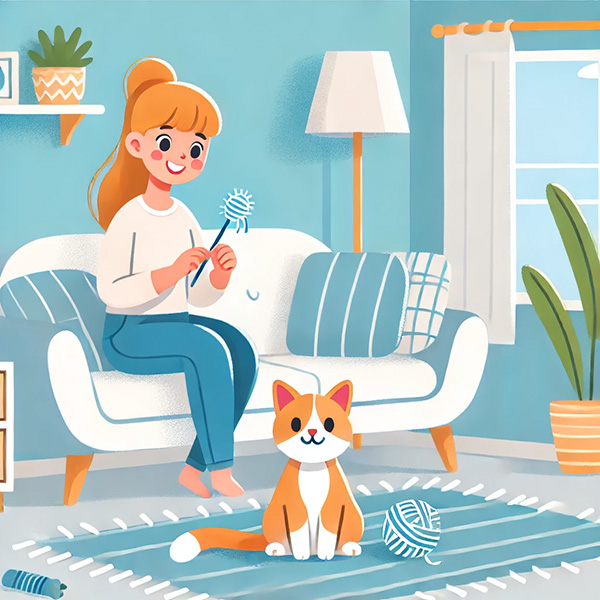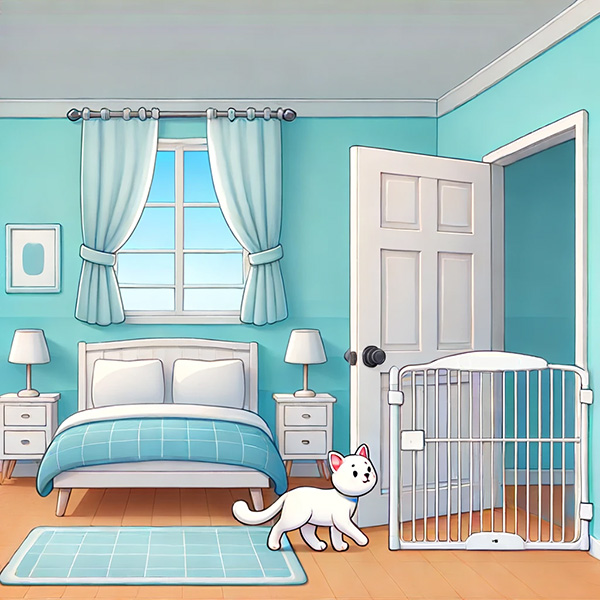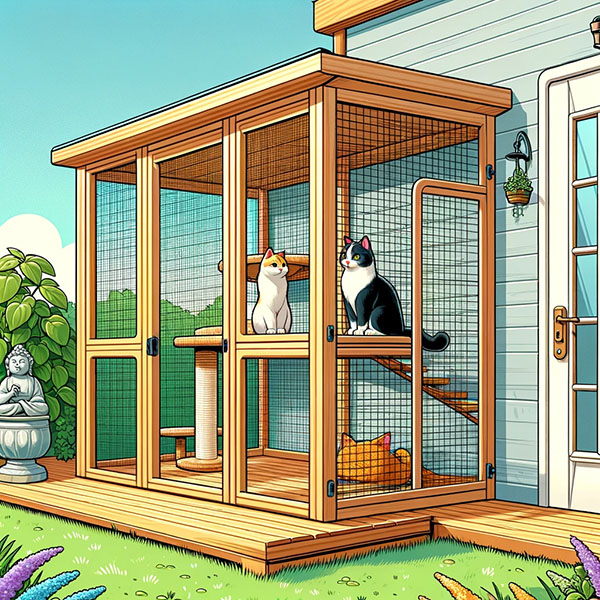Cats are naturally curious and instinctive hunters, driven by an innate desire to explore and monitor their territory. One of the most common indoor cat behaviors that can occur is your cat darting out the front door as soon as it opens. This behavior, often referred to as "door dashing," is not only alarming for a cat owner but can pose serious risks to your cat’s safety. However, the outside environment can be unsafe for a domesticated cat, exposing them to traffic, predators, and other hazards.
It can be stressful for cat owners to try keeping an escape artist kitty inside. In this blog post, we'll explore effective strategies to curb this behavior, enhancing the safety and well-being of your feline friend while satisfying their curiosity in safer, more controlled ways.
6 Ways To Keep Your Cat From Running Out The Door
Training and Redirection

With proper training and strategic redirection, you can prevent your indoor cats from bolting out the door and keep your cat indoors at all times. Training your cat starts with understanding and using their motivations to your advantage. Begin by ensuring your cat has ample stimulation inside the house—think of climbing structures like cat trees, interactive toys, and regular playtime. This reduces the allure of the outdoors and the cat's escape attempts.
To address the door-dashing behavior directly, you can use a technique called 'door manners'. Train your cat to sit and stay away from the door whenever it is opened. Start by practicing with the door closed: Guide your cat to sit at a safe distance from the door and reward them with treats for staying put. Gradually move to training with the door ajar, always reinforcing calm behavior with their favorite rewards.
In addition, you can train your cat to go to a specific spot away from the door whenever you enter or exit. You can use treats or toys to lure your cat to this spot and reward them for staying there. Over time, your cat will associate your arrival or departure with going to their designated spot instead of darting toward the door.
Redirection is also crucial. If your cat approaches the door, gently redirect its attention with a toy or lead it to another activity that will engage it, like a puzzle feeder. Consistency is key—over time, your cat will learn that staying inside is much more rewarding than attempting to escape.
Environmental Enrichment

Enriching your indoor cat's environment can keep it engaged and less interested in escaping. A stimulating indoor environment can greatly diminish your cat's interest in the outdoors, making it less likely to attempt escapes. The more entertained and satisfied your cat is inside, the less likely it will be to attempt to escape.
Start by considering your cat’s vertical space needs. Cats enjoy climbing and surveying their surroundings from elevated positions. Install cat shelves, set up a cat tree, or add window perches with a cat bed where your cat can gaze outside safely. This satisfies their climbing instinct and keeps their curiosity piqued with outdoor visuals from a secure viewpoint.
Interactive toys also play a crucial role. Regularly rotating toys and incorporating puzzle feeders that provide mental stimulation can help keep cats engaged and focused indoors. Additionally, consider incorporating regular play sessions into your routine. Engage cats' natural hunting instincts by using toys that mimic the movement of prey, such as feather wands or laser pointers.
Lastly, don't overlook the power of scent. Catnip or pheromone diffusers can create a calming and appealing indoor atmosphere. Enriching your cat’s environment makes the indoors just as interesting and satisfying as the world outside, reducing their desire to escape.
Physical Barriers and Deterrents

Incorporating physical barriers and deterrents is an effective way to prevent your cat from dashing out the door. These strategies work by either blocking access or making the area less appealing to your feline friend.
Installing a sturdy screen door can serve as an excellent physical barrier. This enables you to enjoy fresh air while keeping your cat safely indoors. Ensure the screen is durable enough to withstand scratching or climbing. Alternatively, strategically placing baby gates can discourage or delay your cat from reaching the door.
For deterrents, consider using a motion-activated device that emits a gentle, harmless spray or noise when your cat approaches the door. Cats are generally averse to sudden noises or surprises, which makes these devices highly effective in deterring them from venturing too close to exits. Aluminum foil or a scat mat can be used to discourage your cat and make the area less attractive to them.
Additionally, double-sided tape or a scat mat near the doorway can be beneficial. Cats dislike the sticky texture of tape and the unusual feel of scat mats on their paws, deterring them from walking through these areas.
Behavioral Adjustments
Behavioral adjustments can help prevent your cat from running out the door. These adjustments focus on modifying your cat’s reaction to the door opening and creating a routine that discourages this behavior.
First, it’s crucial to remain calm and avoid chasing or yelling at your cat when it approaches the door; this can inadvertently turn door-dashing into a game or trigger anxiety-driven behavior. Instead, reward your cat with treats and praise for staying calm and avoiding the door when it opens.
Training sessions are highly beneficial. Teach your cat a "stay" command by using treats to reward them for remaining seated or lying down at a safe distance from the door. Over time, your cat will associate staying away from the door with positive outcomes.
Additionally, if your cat tends to run towards the door during certain times, such as when you come home, redirect their attention with a predictable routine. Have a specific toy or treat ready that you only use at these times. This not only distracts them but also builds a habit of expecting and engaging in a positive activity away from the door.
Install A Cat Door
Installing a cat door is a strategic solution to manage a cat's desire to explore outdoors safely, especially for outdoor cats. This method will not work for any indoor-only cat. However, if your indoor-only cat escapes regularly and comes back a few minutes or hours later, it may be worth considering adding a cat door.
A cat door can provide your pet with controlled access to a secured area, such as a fenced backyard or a cat enclosure, allowing it to satisfy its curiosity without the risks of free-roaming.
When choosing a cat door, consider one with adjustable security settings. Many modern cat doors come with locking mechanisms that can be set to allow only exit, only entry, both, or complete lock-down. This flexibility ensures you can control your cat’s outdoor access according to your daily routine and safety needs.
Installation should be thoughtfully planned. Place the pet door away from busy streets and potential hazards. If you're concerned about other animals entering, look for a door with microchip technology. These doors only open for your cat, detected via their microchip or a special collar, ensuring no unwanted guests come inside.
Lastly, gradually introducing your cat to the new door is essential. Encourage your cat to pass through calmly using treats and positive reinforcement. This will help them feel comfortable and secure with their new portal to adventure.
Spayed Or Neutered
If you have a young cat that suddenly wants to go out, it's time to consider spaying or neutering. Spaying or neutering is a surgical procedure that removes your cat's reproductive organs, which has several behavioral and health benefits. Spaying or neutering your cat will curb their desire to roam and escape through the door to mate.
Behaviorally, spayed or neutered cats are less likely to exhibit roaming behaviors driven by their instincts to find a mate. This reduces their motivation to dart out the door whenever it opens. Neutered male cats are less prone to marking territory or spraying indoors, and spayed females won't undergo heat cycles, which can cause restlessness and heightened vocalization.
From a health standpoint, spaying or neutering decreases the likelihood of certain cancers and other health concerns, promoting a longer, healthier life. Additionally, it aids in managing the pet population, diminishing the occurrence of unwanted kittens.
Additional Safety Measures
Microchipping and Identification

Having your cat microchipped is a reliable form of permanent identification. You can also have your cat wear a safety collar with a tag; however, some cats don't like to wear anything around their neck.
Microchips offer a secure means of identification that remains intact for the lifetime of your pet, unlike collars which can break or be lost. It's crucial to register the microchip and keep your contact information current. Additionally, a collar with an ID tag should have your current contact information, making it easy for someone to reach you if they find your cat.
Routine Security Checks
Regularly check the integrity of your cat-proofing solutions, including the condition of barriers, the functionality of locks, and the battery life of automated devices. Regular maintenance to ensure everything is in working order can prevent unforeseen malfunctions that might result in your cat escaping.
Create A Safe Outdoor Space For Your Cat

Having a secure outdoor environment allows pet owners to decide whether or not to let cat explore the outdoors without the dangers associated with free roaming. Creating a safe outdoor space for your cat can be an effective way to satisfy their natural curiosity and reduce the risk of them darting out the door.
One of the best ways to provide this is by constructing a "catio" — an enclosed patio designed specifically for cats. These can range from simple window box designs to elaborate floor-to-ceiling structures. Ensure the enclosure is made with sturdy materials and is securely anchored to prevent any escapes.
Alternatively, you can use a high-quality, escape-proof harness and leash to give your cat a taste of the outdoors under your supervision. This approach aids in gradually acclimating your cat to the outside world within a controlled environment.
Additionally, consider fencing solutions specifically designed to keep cats within your yard, such as cat-proof fencing that curves inward at the top, making it difficult for cats to climb over.
